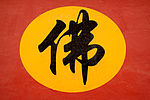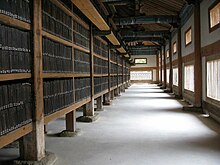| Part of a series on |
| Chinese Buddhism |
|---|
 |


| Part of a series on |
| Buddhism |
|---|
 |
The Chinese Buddhist canon refers to a specific collection of Chinese language Buddhist literature that is deemed canonical in Chinese, Japanese, Korean, and Vietnamese Buddhism.[1][2][3] The traditional term for the canon is "Great Storage of Scriptures" (traditional Chinese: 大藏經; simplified Chinese: 大藏经; pinyin: Dàzàngjīng; Japanese: 大蔵経; rōmaji: Daizōkyō; Korean: 대장경; romaja: Daejanggyeong; Vietnamese: Đại tạng kinh).[3] The concept of the Chinese Buddhist canon was influenced by the Indian Buddhist concept of a Tripitaka, literally meaning 'three baskets' - sutras, Vinaya, and Abhidharma. However, Chinese Buddhists historically did not have access to a Tripitaka of Indian Buddhist texts.[4] Rather, individual texts were brought to China separately or in small batches and translated one-by-one. This led to the creation of a distinct Chinese canon.[5]
- ^ Han, Yongun; Yi, Yeongjae; Gwon, Sangro (2017). Tracts on the Modern Reformation of Korean Buddhism. Jogye Order of Korean Buddhism (published September 20, 2017).
- ^ Storch, Tanya (2014). The History of Chinese Buddhist Bibliography: Censorship and Transformation. Cambria Press (published March 25, 2014).
- ^ a b Jiang Wu, "The Chinese Buddhist Canon" in The Wiley Blackwell Companion to East and Inner Asian Buddhism, p. 299, Wiley-Blackwell (2014).
- ^ Jiang Wu, "The Chinese Buddhist Canon through the Ages: Essential Categories and Critical Issues in the Study of a Textual Tradition" in Spreading Buddha's word in East Asia: the formation and transformation of the Chinese Buddhist canon, p. 23, ed. Jiang Wu and Lucille Chia, New York: Columbia University Press (2015)
- ^ Lancaster, Lewis, "The Movement of Buddhist Texts from India to China and the Construction of the Chinese Buddhist Canon", pp. 226-227, in Buddhism Across Boundaries--Chinese Buddhism and the Western Regions, ed. John R McRae and Jan Nattier, Sino-Platonic Papers 222, Philadelphia, PA: Department of East Asian Languages and Civilizations, University of Pennsylvania (2012)